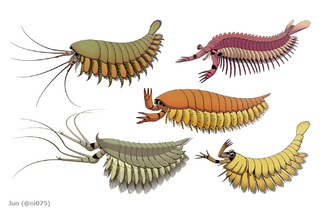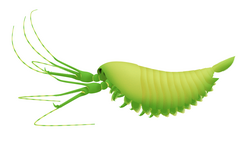Biology:Megacheira
| Megacheira | |
|---|---|

| |
| Alalcomenaeus (top left), Fortiforceps (top right), Haikoucaris (middle), Leanchoilia (bottom left) and Yohoia (bottom right). | |
| Scientific classification | |
| Domain: | Eukaryota |
| Kingdom: | Animalia |
| Phylum: | Arthropoda |
| Class: | †Megacheira Hou and Bergström, 1997 |
| Groups | |
| |
Megacheira ("great hands", also historically great appendage arthropods) is an extinct class of predatory arthropods defined by their possession of spined "great appendages".[1] Their taxonomic position is controversial, with studies either considering them stem-group euarthropods, or stem-group chelicerates.[2] The homology of the great appendages to the cephalic appendages of other arthropods is also controversial. Uncontested members of the group were present in marine environments worldwide from the lower to middle Cambrian.
Morphology
Megacheirans are defined by their possession of uniramous "great appendages", which are their first pair of head appendages. The first one or two proximalmost segments/podomeres are spineless (it has been argued that the supposed first of the two proximal podomeres is actually an arthrodial membrane[3]), while the remaining 3-4 more distal podomeres each typically bore a single upward pointing spine attached towards the distal end of the segment, with the spineless proximal segment/s typically being connected to the spined distal segments by an elbow-like joint, which curled upwards.[4][3] The great appendages have been interpreted as raptorial limbs involved in predation, with those of some genera such as Yohoia being structurally comparable to the raptorial maxillipeds of mantis shrimp.[4] The spines on the great appendages of leanchoilid megacheirans such as Leanchoilia and Yawunik are elongated into flagella-like structures, suggesting a sensory role alongside predatory function.[5] The body is divided into the head and the trunk. The biramous limbs of megacheirans are homonomous (i.e. having little differentiation from each other), with endopods typically divided into seven segments/podomeres, and paddle-shaped exopods, which are fringed with thin lamellae. The morphology of the terminal telson segment is variable.[3] The biramous limbs of at least some megacheirans have been suggested to have borne exites.[6]
Life reconstruction of Fortiforceps (left) and Sklerolibyon (right)
Life restoration of Jianfengia
Closeup of great appendages of Leanchoilia superlata
Life restoration of Yawunik
Taxonomy
Several subdivisions within the group are recognised including Jianfengiidae (including Fortiforceps, Jianfengia, Sklerolibyon and possibly Parapeytoia) which are known from the Early Cambrian of China, as well as the Cheiromorpha (containing at least Yohoia, Haikoucaris, and Leanchoiliidae), known with certainty from the Early-Mid Cambrian of North America, China and Australia, which is distinguished from Jianfengiidae by having a fewer number of body segments (20+ in Jianfengiidae, as compared to typically only 11 to 13 in Cheiromorpha). The monophyly of Megacheira is uncertain, with some studies recovering the group as paraphyletic.[3]
Parapeytoia, which formerly misinterpreted as a radiodont was later suggested to be a member of this group.[7][8][9] Possible megacheirans include Enalikter described from the Silurian of the United Kingdom , and Bundenbachiellus from the Early Devonian of Germany ;[10][11] due to their possession of great appendage-like cephalic appendages. However, their relationship to megacheirans has been questioned, due to the uncertain homology of their appendages.[12] Kootenichela has been suggested to be a chimera of various arthropod taxa.[3] Previous inclusion of some "bivalved" genera such as Forfexicaris, Ovalicephalus, and Occacaris to Megacheira was questioned by later investigations.[13] The Late Cambrian Orsten taxon Oelandocaris typically considered to be a crustacean relative, has also been suggested in some studies to be a megacheiran.[14]
Relationship to other arthropods
Megacheirans are either suggested to be stem-group chelicerates or stem-group arthropods,[2] with the former hypothesis based on the chelicerae-like morphology of the great appendages[15][16][17] alongside neuroanatomy[18] and the presence of a reduced labrum[19] resembling those of modern chelicerates, it being argued that chelicerae and the great appendages are homologous structures.[20] Other studies suggest that the megacheirans are stem-group arthropods based on the argument that the great appendages are homologous to the frontal appendages of stem-group arthropods like Isoxys and radiodonts. This identity is disputed, with other authors suggesting that the frontal appendages of radiodonts are homologous to the labrum of modern arthropods.[3]
References
- ↑ Stein, Martin (March 2010). "A new arthropod from the Early Cambrian of North Greenland, with a 'great appendage'-like antennula". Zoological Journal of the Linnean Society 158 (3): 477–500. doi:10.1111/j.1096-3642.2009.00562.x.
- ↑ 2.0 2.1 Aria, Cédric (2022-04-26). "The origin and early evolution of arthropods" (in en). Biological Reviews 97 (5): 1786–1809. doi:10.1111/brv.12864. ISSN 1464-7931. PMID 35475316. https://onlinelibrary.wiley.com/doi/10.1111/brv.12864.
- ↑ 3.0 3.1 3.2 3.3 3.4 3.5 Aria, Cédric; Zhao, Fangchen; Zeng, Han; Guo, Jin; Zhu, Maoyan (December 2020). "Fossils from South China redefine the ancestral euarthropod body plan" (in en). BMC Evolutionary Biology 20 (1): 4. doi:10.1186/s12862-019-1560-7. ISSN 1471-2148. PMID 31914921.
- ↑ 4.0 4.1 Haug, Joachim T.; Waloszek, Dieter; Maas, Andreas; Liu, Yu; Haug, Carolin (March 2012). "Functional morphology, ontogeny and evolution of mantis shrimp-like predators in the Cambrian: MANTIS SHRIMP-LIKE CAMBRIAN PREDATORS" (in en). Palaeontology 55 (2): 369–399. doi:10.1111/j.1475-4983.2011.01124.x.
- ↑ Aria, Cédric; Caron, Jean-Bernard; Gaines, Robert (2015). "A large new leanchoiliid from the Burgess Shale and the influence of inapplicable states on stem arthropod phylogeny". Palaeontology 58 (4): 629–660. doi:10.1111/pala.12161.
- ↑ Liu, Yu; Edgecombe, Gregory D.; Schmidt, Michel; Bond, Andrew D.; Melzer, Roland R.; Zhai, Dayou; Mai, Huijuan; Zhang, Maoyin et al. (2021-07-30). "Exites in Cambrian arthropods and homology of arthropod limb branches". Nature Communications 12 (1): 4619. doi:10.1038/s41467-021-24918-8. ISSN 2041-1723. PMID 34330912.
- ↑ Stein, Martin (2010-03-01). "A new arthropod from the Early Cambrian of North Greenland, with a 'great appendage'-like antennula" (in en). Zoological Journal of the Linnean Society 158 (3): 477–500. doi:10.1111/j.1096-3642.2009.00562.x. ISSN 0024-4082. https://academic.oup.com/zoolinnean/article/158/3/477/3798454.
- ↑ Xian-Guang, Hou; Siveter, David J.; Siveter, Derek J.; Aldridge, Richard J.; Pei-Yun, Cong; Gabbott, Sarah E.; Xiao-Ya, Ma; Purnell, Mark A. et al. (2017-04-24) (in en). The Cambrian Fossils of Chengjiang, China: The Flowering of Early Animal Life. John Wiley & Sons. ISBN 9781118896389. https://books.google.com/books?id=2YWhDgAAQBAJ&q=Tanglangia&pg=PA184.
- ↑ Daley, Allison C.; Budd, Graham E.; Caron, Jean-Bernard; Edgecombe, Gregory D.; Collins, Desmond (2009-03-20). "The Burgess Shale Anomalocaridid Hurdia and Its Significance for Early Euarthropod Evolution" (in en). Science 323 (5921): 1597–1600. doi:10.1126/science.1169514. ISSN 0036-8075. PMID 19299617.
- ↑ Siveter, Derek J.; Briggs, Derek E. G.; Siveter, David J.; Sutton, Mark D.; Legg, David; Joomun, Sarah (7 March 2014). "A Silurian short-great-appendage arthropod". Proceedings of the Royal Society B 281 (1778): 20132986. doi:10.1098/rspb.2013.2986. PMID 24452026.
- ↑ Derek J. Siveter; Derek E. G. Briggs; David J. Siveter; Mark D. Sutton; David Legg; Sarah Joomun (2015). "Enalikter aphson is an arthropod: a reply to Struck et al. (2014)". Proceedings of the Royal Society B 282 (1804): 20142663. doi:10.1098/rspb.2014.2663.
- ↑ Aria, Cédric (October 2022). "The origin and early evolution of arthropods" (in en). Biological Reviews 97 (5): 1786–1809. doi:10.1111/brv.12864. ISSN 1464-7931. PMID 35475316. https://onlinelibrary.wiley.com/doi/10.1111/brv.12864.
- ↑ Ortega-Hernández, Javier; Janssen, Ralf; Budd, Graham E. (2017-05-01). "Origin and evolution of the panarthropod head – A palaeobiological and developmental perspective". Arthropod Structure & Development. Evolution of Segmentation 46 (3): 354–379. doi:10.1016/j.asd.2016.10.011. ISSN 1467-8039. PMID 27989966.
- ↑ Aria, Cédric; Caron, Jean-Bernard (May 2017). "Burgess Shale fossils illustrate the origin of the mandibulate body plan" (in en). Nature 545 (7652): 89–92. doi:10.1038/nature22080. ISSN 0028-0836. PMID 28445464. http://www.nature.com/articles/nature22080.
- ↑ Chen, Junyuan; Waloszek, Dieter; Maas, Andreas (2004). "A new 'great-appendage' arthropod from the Lower Cambrian of China and homology of chelicerate chelicerae and raptorial antero-ventral appendages" (in en). Lethaia 37 (1): 3–20. doi:10.1080/00241160410004764. ISSN 1502-3931.
- ↑ Chen, Jun-Yuan (2009). "The sudden appearance of diverse animal body plansduring the Cambrian explosion". The International Journal of Developmental Biology 53 (5–6): 733–751. doi:10.1387/ijdb.072513cj. ISSN 1696-3547. PMID 19557680.
- ↑ Haug, Joachim T.; Waloszek, Dieter; Maas, Andreas; Liu, Yu; Haug, Carolin (March 2012). "Functional morphology, ontogeny and evolution of mantis shrimp-like predators in the Cambrian: MANTIS SHRIMP-LIKE CAMBRIAN PREDATORS" (in en). Palaeontology 55 (2): 369–399. doi:10.1111/j.1475-4983.2011.01124.x.
- ↑ Tanaka, Gengo; Hou, Xianguang; Ma, Xiaoya; Edgecombe, Gregory D.; Strausfeld, Nicholas J. (17 October 2013). "Chelicerate neural ground pattern in a Cambrian great appendage arthropod". Nature 502 (7471): 364–367. doi:10.1038/nature12520. PMID 24132294.
- ↑ Liu, Yu; Ortega-Hernández, Javier; Zhai, Dayou; Hou, Xianguang (2020-06-25). "A Reduced Labrum in a Cambrian Great-Appendage Euarthropod" (in en). Current Biology 30 (15): 3057–3061.e2. doi:10.1016/j.cub.2020.05.085. ISSN 0960-9822. PMID 32589912.
- ↑ Tanaka, Gengo; Hou, Xianguang; Ma, Xiaoya; Edgecombe, Gregory D.; Strausfeld, Nicholas J. (2013-10-17). "Chelicerate neural ground pattern in a Cambrian great appendage arthropod" (in en). Nature 502 (7471): 364–367. doi:10.1038/nature12520. ISSN 0028-0836. PMID 24132294. http://www.nature.com/articles/nature12520.
Wikidata ☰ Q1946246 entry
 |







